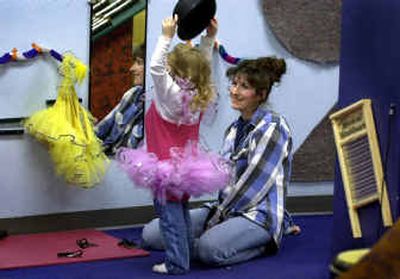Children’s museums thing of the future

Is America obsessed with its children?
It would seem so from the explosion of children’s museums nationwide. More than 25 have opened since 2000, continuing a building boom that began in the 1980s.
“The trend shows no signs of slowing,” says Janet Rice Elman, executive director of the Association of Children’s Museums in Washington, D.C., which has a list of 70 more children’s museums that are under construction or in the planning stages.
Major children’s museums have opened recently in Atlanta, Miami, Pittsburgh and Columbia, S.C. Large new ones are in the works in Washington, D.C., and Philadelphia. And children’s museums in Boston and Chicago plan major expansions.
In Spokane, longtime plans to build a new children’s museum seem to be coming to fruition. Last month, the group backing the children’s museum partnered with the group behind a proposed Riverfront Park science center. The new organization is called Mobius.
Mobius at River Park Square, as the Spokane museum is now called, is slated to open in a 16,000-square-foot space in the downtown mall this summer. Construction is scheduled to begin next month.
So far, about three-quarters of the $800,000 needed to build and open the museum has been raised, says Mobius executive director Gage Stromberg.
The remaining funds will be solicited from past supporters, Stromberg says, with a public fund-raising drive due in coming months.
Many cities now see children’s museums as a magnet for tourism, much as aquariums and art museums have been in the past. And, indeed, children’s museums increasingly are on the agenda for traveling families.
“They’re something parents look for now when they travel,” says Catherine Horne, executive director of EdVenture in Columbia, S.C., which opened 16 months ago and is the largest in the South. “We’ve had people from every state except North Dakota.”
EdVenture, which drew 250,000 visitors in its first year (100,000 more than projected), is typical of the new wave of children’s museums. Bigger, brighter and bolder than its predecessors, the $19 million, five-story building was designed from the beginning to be one of the South Carolina capital’s main draws, and it offers an array of larger-than-life attractions. Among them: Eddie, a 40-foot-high, plastic-molded boy that kids can play on and within (they can climb inside his stomach, wiggle through his brain and slide out his intestines).
Like other exhibits at the museum, Eddie is intended to offer a mix of learning (about anatomy) and fun — and not just for the kids. “We wanted parents to learn how to play again, and to get down on their children’s level,” Horne says.
The concept of a children’s museum dates back more than a century. The first in the United States opened in Brooklyn in 1899. But it wasn’t until the 1980s that they started becoming more common. And in the 1990s they really took off (more than 80 opened).
Several factors have been driving the trend, Rice Elman says. For starters, parents are seeking more informal learning environments for their kids as a break from the increasing structure at schools. “The school environment has become very focused on achievement. Children’s museums are focused on the child,” she says.
Another factor is America’s concern with safety; children’s museums are perceived as safe havens for play. They also benefit as families look for ways to spend more time together.
“With more and more dual-income parents, unstructured leisure time is decreasing,” Rice Elman says. “There’s a need to really maximize that leisure time, to make the weekend or vacation memorable.”
One recent twist is a move away from the trend of sprinkling attractions with high-tech computer screens and video monitors.
“We tried to do a no-screen museum,” says Jane Werner, executive director of the Children’s Museum of Pittsburgh, which reopened in November after quadrupling in size. “We kind of had this mantra of (kids should) play with real stuff. We think the real learning happens between families and with conversations that they have (while playing).”
The Pittsburgh museum is loaded with areas for role playing where the whole family can get involved, such as a pretend car garage and a woodshop. There’s also an art studio filled with supplies.
Like other new children’s museums, Pittsburgh also has tried to make its activities appeal to a wide spread of ages, from the littlest toddlers to teenagers.
Says Werner: “We don’t think childhood should end at 10.”